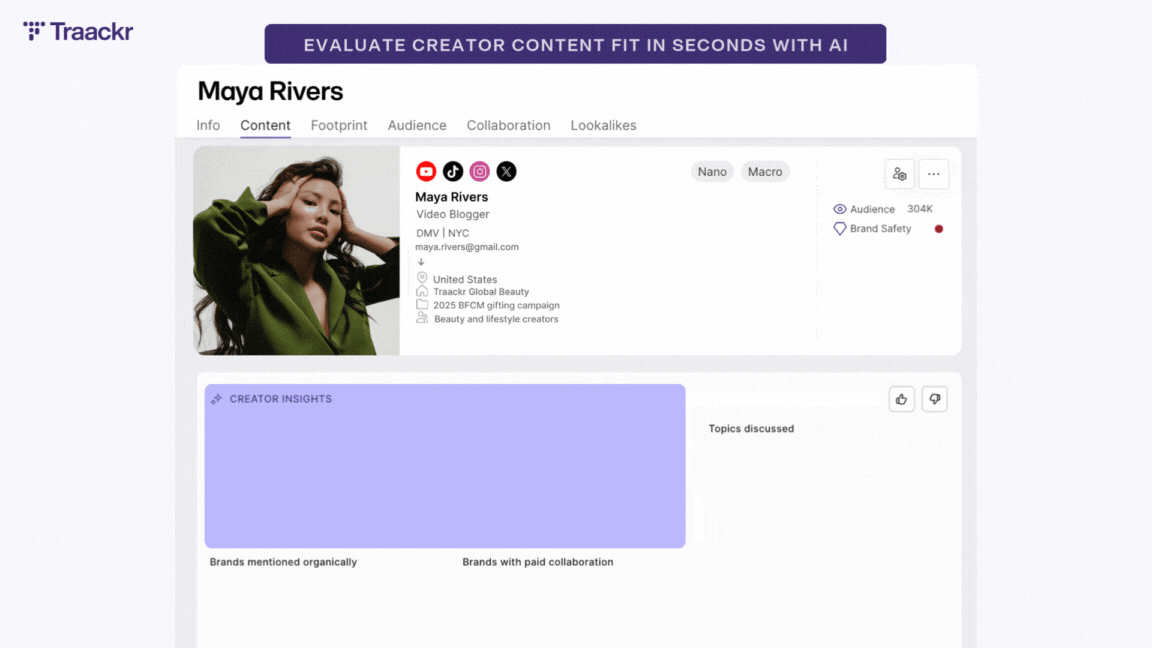
Your brand’s reputation in influencer marketing depends on the partners you choose.
The biggest threat in this space is the potential damage from an influencer’s actions, whether past or present, online or offline. That is why risk management must be twofold: proactive vetting to prevent issues, and reactive planning to limit damage when something does go wrong.
Proactive Risk Mitigation: The Influencer Vetting Process
Vetting is more than a quick check of follower counts. It is a deliberate process to confirm whether an influencer aligns with your brand’s values, ensure they have a genuine audience, and spot issues before you sign a contract. You want to mitigate your risk of damaging your brand’s reputation.
A Step-by-Step Vetting Framework
A written, repeatable vetting process ensures consistency and confidence in your decisions:
- Define Brand Values and Red Lines: Create a risk assessment scorecard before you begin. Be clear on your non-negotiables, such as zero tolerance for hate speech, discrimination, violence, or disinformation.
- Audit the Digital Footprint: Go beyond an influencer’s polished feed. Review their full content history, including past posts, videos, comments, and tagged content, to flag any potential conflicts with your brand’s standards.
- Verify Audience: Fake followers and inflated engagement are costly. Use advanced analytics to detect suspicious audience patterns. A fake audience not only ruins ROI but can damage your credibility.
- Review Past Brand Collaborations: Look at how they have represented other brands. Did they disclose properly? Did the content feel natural? Were there partnerships with competitors?
- Run External Searches: Google their name and any known aliases. News articles, blogs, and forums can reveal concerns not visible on social platforms.
At scale, manual vetting is slow and inconsistent. Brands need technology that can automate, standardize, and strengthen this process. This is where Traackr’s robust vetting capabilities provide a significant advantage.
How Traackr Helps Brands Vet Influencers with Confidence
Traackr’s platform is built to give brands a complete, data-driven view of a creator before they engage.
- Spot Risk Before It Becomes a Crisis: Scan a creator’s historic content across social platforms, flagging potential issues against your custom red lines.
- Verify Audience Integrity: Traackr’s fraud detection tools uncover suspicious patterns, ensuring your investment reaches real, engaged audiences.
- Benchmark and Compare: Evaluate creators side-by-side with competitive and category benchmarks so you can choose the best fit for your campaign goals.
The result is faster decisions, fewer surprises, and partnerships you can stand behind both publicly and proudly. And now, with Traackr’s AI Content Summaries, you get instant insight into a creator’s voice, topics, and brand mentions, helping you evaluate content fit in seconds and move through vetting with even greater confidence.

Reactive Risk Mitigation: The Creator Crisis Management Playbook
Even with world-class vetting, issues can arise, whether from the influencer’s actions, a campaign misstep, or public backlash. That is where preparation pays off.
The Three Phases of Crisis Management
Pre-Crisis (Preparation)
- Contractual Safeguards: Include a strong morality clause and clear termination rights in all of your influencer agreements.
- Organise the Team: Organise a crisis comms team in advance with clear roles, covering senior PR, Legal, Social Media, and Marketing leaders.
- Craft Pre-Approved Statements: Develop pre-approved, template holding statements that can be quickly adapted to acknowledge a situation while the team investigates.
- Recruit and Maintain Allies: Develop genuine, long-term relationships with a core group of well-respected influencers. They may be able to provide a credible voice on behalf of the brand in a moment of crisis.
Crisis Response (First Hour is Critical)
- Assess and Pause: Gauge the severity of the situation and halt scheduled content to avoid tone-deaf messaging.
- Own Up and Apologize: Acknowledge the issue, publicly apologize if appropriate, and communicate clearly. When the brand has been at fault, an honest, candid apology is appropriate. Deleting nasty comments or remaining stony about the problem only serves to worsen it.
- Control the Narrative: Use your owned social channels to communicate the official response and outline the steps being taken. If appropriate, your trusted influencer partners can help to humanize the brand response too.
Post-Crisis (Recovery and Learning)
- Analyze: Conduct a thorough review to identify root causes and improve processes.
- Rebuild: Take meaningful actions that demonstrate your values in practice. That might mean bringing real changes to product or process, or launching new campaigns that instill values of the brand.
- Refine: Update your vetting process, contracts, and playbook with lessons learned.
In a crisis, PR wants speed and empathy. Legal wants precision and protection. The most effective responses are those crafted together from the very start. The goal is to create messages that are both defensible in court and credible in the court of public opinion. Legal and PR must get it done together from minute one.
.png)